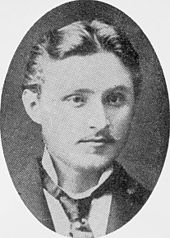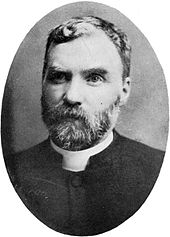Tin Can Cathedral
By 1903 the Ukrainian immigrant population in Western Canada had become large enough to attract the attention of religious leaders, politicians, and educationalists.
[1] Genik was a friend of Ivan Franko, the Ukrainian author of "Лис Микита" (Fox Mykyta)[2] who was nominated for the Nobel Prize In Literature.
Franko's biting satire on the Western Ukrainian clergy of his day and his socialist leanings were probably shared by Genik who happened to be best man at the author's wedding.
Upon his arrival in Canada, Genik became the first Ukrainian to be employed by the Canadian government, and worked as an immigration agent taking new settlers out to their homesteads.
[1] These three men constituted the nucleus of the intelligentsia in the Ukrainian community, and were known as the "Березівська Трійця" (romanized: Berezivs'ka Triitsya) (the "Bereziv Triumvirate").
Archbishop Adélard Langevin, who was located in St. Boniface, was the head of the Roman Catholic diocese in Western Canada, in direct contact with Pope Pius X in Rome.
"[6]: 189 Archbishop Langevin declared "the Ruthenians must prove themselves Catholics by turning property over to the church, and not like Protestants …to an individual or committee of laymen, independent of the priest or bishop.
He provided the parishioners with an Eastern Rite with which the immigrants were familiar, began to ordain cantors and deacons, and "…on 13th December 1903, a small frame building on the east side of McGregor Street between Manitoba and Pritchard Avenues, that may have been called the Holy Ghost church, was officially blessed by Seraphim and opened for worship.
"[10] "In November 1904 he started building his notorious 'tin can cathedral' at the corner of King Street and Stella Avenue,…"[10] made of scrap metal and wood.
In two years this church claimed nearly 60,000 adherents…"[11] "Due to various indiscretions and problems with alcohol"[8] he lost the trust of the intelligentsia who had invited him to Winnipeg, and a coup took place in which they moved to get rid of him while not losing his congregation.
Seraphim disappeared by 1908, but there are accounts of him in Ukrainskyi Holos (the Ukrainian Voice newspaper, still being published today in Winnipeg) selling Bibles to workers building railroads in British Columbia as late as 1913.
Cyril Genik moved with his eldest daughter and one of his sons to the United States, to North Dakota for a time, then returned and died in 1925.
Makarii Marchenko, upon Seraphim's departure, declared himself not only the new Bishop of the Seraphimite Church, but also Arch-Patriarch, Arch-Pope, Arch-Hetman, and Arch-Prince.





